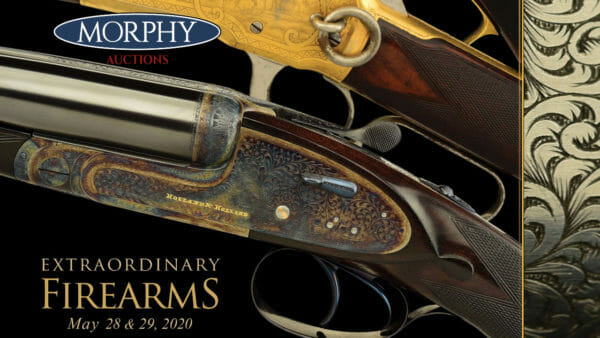
Denver, PA -(AmmoLand.com)- In my line of work, I’ve been very fortunate to handle (and sometimes shoot) a number of exceptionally rare and/or historic firearms. While it has made me jaded in some ways, there are still some pieces that I admit to geeking out about when I see them.
There are more than 700 lots available during Morphy Auctions’ Extraordinary Firearms Auction coming up on May 28-29, but I’ve managed to narrow it down to my five favorites. In no particular order, they are:
North Korean Type 58 Machine Gun – Estimate: $35,000-$45,000

This AK-style machine gun is a bit of a unicorn. There are very few examples in the US that are able to be owned legally. How, then, did this one come to be stateside? Well, it was originally a cut gun. Someone took great care to reweld, refinish, and register this machine gun. The job is so well done that you can really only notice it from the outside if you’re looking for it.
Among collectors, the North Korean folding stock Type 58 is among the rarest and most sought after of all the AK variants. Adding to its appeal, the gun has visible matching numbers on the forend, receiver, bolt, and mainspring guide rod. The Korean star within circle proof, model markings, serial number, and selector markings are all there, too, and in excellent condition. This is the only one I’ve handled.
CIA Deer Gun – Estimate: $2,500-$5,000

This is a neat single-shot pistol that I’ve come to call the “Liberator 2.0” as it is most easily explained as the more modern version of the single-shot pistols made from stamped sheet metal during World War II. Exact specifics about these guns are nearly impossible to pin down; there’s a lot of speculation in books and videos and, while some of it is the same across the board, there are some differences. These include their year of introduction, intended purpose, place of manufacture, number made, and even the correct spelling of the name.
Two personal notes:
- Even though there’s one on display in the CIA Museum in DC, their Curator would neither confirm nor deny any of the questions I asked about it when I was there.
- I’ve handled six and seen a total of eight.
Singer 1911A1 Pistol – Estimate: $125,000-$175,000

These are considered to be the “Holy Grail” among 1911A1 collectors. Testing the feasibility of 1911 mass production, the Ordnance Department contracted with Singer in 1925 for an engineering study to see how many guns they could produce in a month. After the study was complete, it was determined that Singer could turn out as many as 25,000 1911s in a month.
In 1939, the Ordnance Department awarded a production study to Singer. The following year, under Educational Order W-ORD-396, Singer set out to make 500 1911A1 pistols in an effort to eventually achieve a production rate of 100 guns per hour.
Singer never hit the production rate goal, but they did fulfill their contract for 500 1911A1s. By 1941, Singer had divested themselves of the 1911 business and transferred their tooling and documentation to Remington Rand. As a result of this, Singers have the lowest production numbers of any 1911 model made in the United States – just 500. I’ve handled three or four of these, but no one’s offered to let me run a mag through one!
Whiskey Barrel Pepperbox – Estimate: $5,000-$7,500

I love weird and wacky arms designs, and this whiskey barrel pepperbox definitely fits that definition. This nine-shot percussion pepperbox has a drop-down door that exposes the muzzle and a matching door that operates the hammer. The trigger is just a small nub protruding from the bottom.
When it comes to collectible guns, provenance is key, and this exact example is featured on page 165 of Lewis Winant’s book “FIREARMS CURIOSA” as identified by staining and imperfections on the sides and ends. Little is known about this unique arm and this appeared to be the only example known. The outer body is constructed of German silver and the gun is operated by opening the muzzle gate and pulling the opposite door latch to the rear, cocking the gun. The body of the barrel rotates to expose the next of nine barrels. A small compartment for storing bullets is in the tenth chamber slot. Obviously, this is the only one I’ve ever seen. Also, if you’re a fan of weird and wacky stuff like I am, then you definitely need to get a copy of Winant’s book!
Annie Oakley’s Stevens Model 44 Rifle – Estimate: $200,000-$400,000

What can I say about Annie Oakley that hasn’t already been said? She was an absolute powerhouse when it came to exhibition shooting and marksmanship in the late 19th and early 20th centuries. She’s also been a source of inspiration for modern shooters of all ages and disciplines.
Annie and her husband Frank moved into their first home together in Nutley, New Jersey, around Christmas 1893. Given that this gun has her name on one side and that location on the other, it’s believed that this was likely a housewarming gift from Stevens. Once again, provenance is key, and this gun has it: it’s pictured on pages 120, 134, and 137 in R.L. Wilson’s book, “BUFFALO BILL’S WILD WEST / AN AMERICAN LEGEND.”
This is the sixth gun of Annie’s that I’ve had the opportunity to handle, and I’ve even shot one of them! (Not this one, though.)
So there you have it. These are lucky ones, making up just 0.7% of the guns at the upcoming auction, that caused this semi-jaded gun guy to stop and take a second look!
